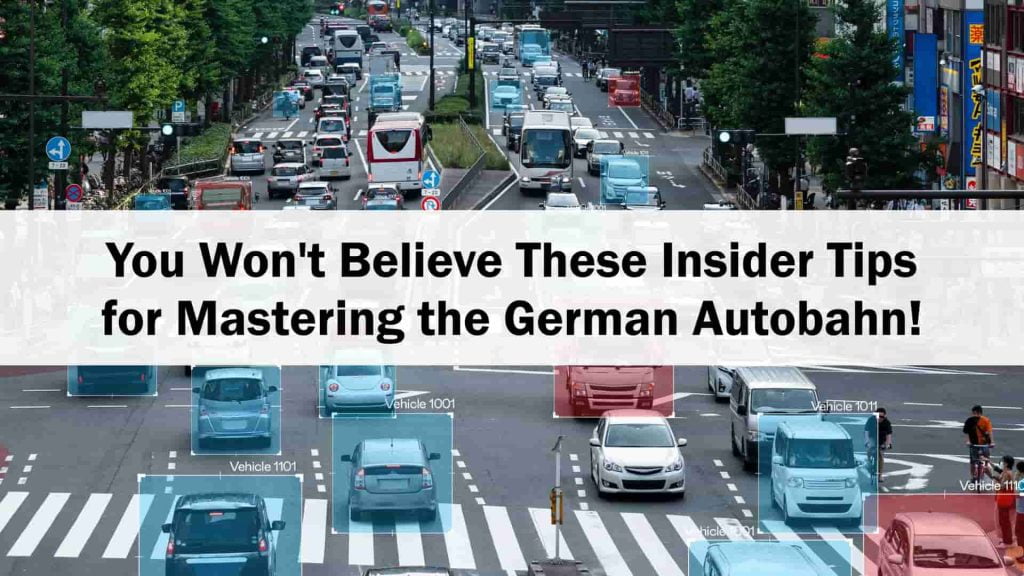
Contrary to popular belief, the Autobahn isn’t just an endless stretch of asphalt beckoning you to push your speedometer to its limits. In fact, those fabled ‘no-limit’ zones? They account for about 70% of this vast network.
So, before you get too cozy with your accelerator, be prepared to ease off in bustling urban settings, meticulously marked construction areas, and those sneaky curves that demand your respect.
And here’s a kicker – even when the road ahead looks like a green light for your inner speed demon, there’s an advisory whispering in the wind: 130 km/h (that’s 81 mph for the metrically uninitiated). Sure, you can breeze past that without breaking any laws, but should things take a tumble, you might find yourself playing a less-than-favorable role in the aftermath.
So, buckle up, we have a lot more tips for you so let’s dive straight in!
Make sure to read: Learning to Love German Winters: 5 Places to Visit in the Winter
5 Important Tips to Keep in Mind When Driving on the Autobahn
Craving a taste of boundless freedom?

The A 24 stretch between Hamburg and Berlin is your playground, boasting a heart-pumping 150 km (93 miles) where your vehicle can truly spread its wings. Here are our tried and tested tips for driving safely on the Autobahn.
#1 Make sure you have a firm understanding of Autobahn etiquette.
Diving headfirst into the Autobahn experience comes with its own set of unspoken rules, a silent dance of high-speed vehicles moving in harmonious synchrony. At the heart of this dance is the ‘Rechtsfahren‘ rule, a fundamental principle that translates to ‘drive on the right, pass on the left.’ This isn’t just a courtesy; it’s the oil that keeps the traffic flowing smoothly and safely.
By sticking to the right lane unless overtaking, you’re not just following the law; you’re respecting a time-honored tradition that ensures efficiency and safety for all. This rule prevents the dreaded ‘lane hogging’ and ensures that the left lane is always available for those who wish to overtake.
The Art of Overtaking on the Autobahn
When it comes to overtaking on the Autobahn, there’s more to it than simply speeding past the vehicle ahead. Here’s a breakdown of the etiquette and legal requirements:
- Always Overtake on the Left: It’s not just good manners; it’s the law. Overtaking from the right is not only frowned upon but also dangerous and illegal.
- Signal Your Intentions: Before you shift lanes to overtake, make sure your turn signals are clearly indicating your move. This simple act can prevent confusion and collisions.
- Check Your Mirrors: With vehicles potentially approaching at high speeds, a quick glance in your mirrors is crucial to ensure the lane is clear.
- Return to the Right: After overtaking, don’t linger in the left lane. Move back to the right when it’s safe, allowing others to overtake as well.

Signaling and Mirror Checks: The Lifelines of Autobahn Driving
At the heart of Autobahn etiquette is the vigilant use of turn signals and mirrors, especially when velocities soar. The act of signaling isn’t just a courtesy; it’s a critical communication tool that bridges the gap between intent and action, giving fellow drivers a heads-up of your next move. In the realm of high-speed Autobahn travel, this simple flick of a lever becomes your voice in the silent ballet of speeding cars.
Equally paramount is the habitual check of your mirrors. With vehicles zipping by at varying speeds, a mere second’s glance in your rearview or side mirrors can unveil a world of crucial information. It tells you who’s coming up fast, who’s hanging back, and most importantly, whether it’s safe to make your next move.
This constant vigilance ensures that when you do decide to glide into the next lane or ease off the accelerator, you’re doing so with the full knowledge of your surroundings, making Autobahn driving not just a thrilling experience but a safe one too.
Also read: How to Open Your First German Bank Account?
#2 Keep a check on speed Limits and recommendations while driving on the Autobahn.
The allure of the Autobahn often conjures images of a boundless, pedal-to-the-metal driving paradise. However, this vision isn’t entirely accurate. While it’s true that certain stretches of the Autobahn invite drivers to test the limits of their speedometers, this isn’t a universal rule.
A significant portion of this famed network enforces speed limits, tailored to enhance safety, manage traffic flow, and protect urban areas from noise and emissions. These regulated zones are strategically placed to ensure that your high-speed adventure doesn’t compromise the well-being of others or the environment.
Speed Limits and Recommendations: A Closer Look
To navigate the complexities of Autobahn speed regulations, here’s a breakdown of where and when limits apply, along with the recommended speeds:
| Area/Condition | Speed Limit | Advisory Speed (Richtgeschwindigkeit) |
| Urban Areas | Varies, typically 50-80 km/h | N/A |
| Construction Zones | Usually 60-80 km/h | N/A |
| Sharp Curves | As indicated by road signs | N/A |
| Unrestricted Sections | No formal limit | 130 km/h |
What are the Possible Consequences of Exceeding the Autobahn Speed Limits?
Exceeding the Autobahn’s speed limits or ignoring the advisory speeds can have significant repercussions:
- Increased Liability: In case of an accident, driving above the advisory speed can shift more fault onto you, impacting insurance claims and legal outcomes.
- Safety Risks: Higher speeds dramatically reduce reaction times and increase stopping distances, elevating the risk of severe accidents.
- Legal Penalties: Speeding in regulated zones can lead to fines, driving bans, and in severe cases, criminal charges.
- Environmental Impact: Excessive speed leads to higher fuel consumption and emissions, contributing to environmental degradation.

We think you’ll love this: 7 Best Day Trips from Berlin for History Buffs
#3 Be composed when handling high speeds safely while driving on the Autobahn.
Before you embrace the high-speed thrills of the Autobahn, ensuring your vehicle is in top condition is paramount. The exhilaration of driving at elevated speeds demands more than just confidence; it requires a vehicle that’s meticulously maintained and primed for performance.
This preparation goes beyond a simple oil check or tire pressure adjustment. It involves a thorough examination of your brakes, ensuring they’re responsive and wear-free, a review of your engine’s health to guarantee it can sustain high speeds, and a scrutiny of your tires, which should be free of damage and properly inflated.
These checks not only safeguard your vehicle’s integrity but also enhance your safety and that of others sharing the road.
Staying Sharp and Vigilant on the Autobahn
Long stretches at high speeds can test even the most seasoned drivers. Here are key tips to keep your mind sharp and fatigue at bay:
- Take Regular Breaks: Every two hours or so, pull over, stretch your legs, and breathe in some fresh air.
- Stay Hydrated: Keep water within reach and sip regularly to stay alert and prevent dehydration.
- Engage Your Mind: Listen to engaging audiobooks or upbeat music to keep your mind active.
- Know Your Limits: Recognize the signs of fatigue, and don’t hesitate to take a break or even a short nap if needed.
The Art of Maintaining Safe Distance on the Autobahn

At the heart of Autobahn safety, especially at high speeds, is the sacred principle of maintaining a safe following distance. This isn’t just a buffer; it’s your reaction time, encapsulated in a stretch of road. As your speed increases, this distance should expand, granting you precious seconds to respond to sudden changes or hazards ahead.
This space becomes your guardian, shielding you from the unforeseen, allowing for a graceful deceleration rather than a panicked reaction. In the high-velocity dance of the Autobahn, where vehicles weave and surge, this principle of distance is your unwavering partner, ensuring that the high-speed ballet remains a spectacle of grace, not a precursor to chaos.
Don’t forget to read: How to Rent a Car in Germany?
#4 Be vigilant when driving around construction zones and in the midst of heavy traffic on the Autobahn.
Construction zones are a frequent sight on the Autobahn, serving as essential intervals of repair and upgrade amidst stretches of high-speed travel. Identifying these zones early is crucial, often signaled by a series of warnings such as signs, flashing lights, and reduced speed limits.
As you approach, it’s vital to reduce speed gradually, adhere to the posted limits, and remain vigilant for sudden changes in traffic flow or unexpected obstacles. These areas may also introduce temporary lanes or shifts in traffic patterns, requiring your full attention and readiness to adapt.
The key is to proceed with caution, respecting the safety of road workers and fellow drivers alike.
Strategies for Traffic Jams When Driving on the Autobahn
When confronted with the inevitable snarl of traffic jams, here are strategies to navigate the congestion with ease:
- Stay Informed: Use real-time traffic apps to anticipate and avoid jammed sections when possible.
- Keep a Cool Head: Patience is your ally in traffic; avoid aggressive lane changes or erratic driving.
- Use Hazard Lights: If you’re at the tail end of a jam, turning on your hazard lights can warn approaching vehicles.
- Consider Alternate Routes: If possible, use exits or alternative paths to circumvent the congestion, but remain mindful of local traffic regulations.
The Role of the Emergency Lane While Driving on the Autobahn
The emergency lane on the Autobahn is reserved for breakdowns and emergency services, not as a shortcut during heavy traffic or accidents. Misuse of this lane not only disrupts the flow of emergency responders but also carries significant legal consequences, including hefty fines and points on your driving record.
In the event of a traffic jam, it’s crucial to keep this lane clear, especially to form an emergency corridor (Rettungsgasse) for rescue vehicles. This practice isn’t just a matter of legal compliance; it’s a vital contribution to the collective safety and efficiency of the Autobahn system.

#5 Give way for all emergency vehicles and follow the breakdown protocol when driving on the Autobahn.
On the Autobahn, the swift passage of emergency vehicles is facilitated by a critical and legally mandated maneuver known as the ‘Rettungsgasse‘ or emergency corridor.
This protocol kicks into gear the moment traffic slows to a crawl, requiring vehicles in the leftmost lane to edge towards the median, while those in adjacent lanes move to the right, thereby carving out a lifeline through the congestion.
This corridor is not merely a courtesy; it’s a legal obligation, underscoring the collective responsibility of drivers to ensure that help reaches those in need without a second’s delay. The formation of this passage can mean the difference between life and death, highlighting the profound impact of collective action in times of crisis.
Your recommended post for the week: A Peek into a Day in German Life
Breakdown and Emergency Protocol When Driving on the Autobahn
In the unfortunate event of a breakdown or emergency on the Autobahn, here are essential steps to ensure your safety and that of others:
- Activate Hazard Lights: Immediately signal distress to approaching vehicles.
- Move to Safety: If possible, steer your vehicle to the nearest emergency lane or breakdown bay.
- Don Reflective Gear: Before exiting the vehicle, don a safety vest to enhance your visibility.
- Place the Warning Triangle: Set up the triangle at a safe distance behind your vehicle to alert other drivers.
- Stay Clear of Traffic: Remain behind the barrier or on the roadside, away from moving vehicles.
- Call for Assistance: Use the emergency phone or your mobile to seek help, providing precise details of your location and situation.
- Signal for Help: If stranded, use your vehicle’s horn or lights to attract attention from passersby or emergency services.

Our Final Thoughts on Driving on the Autobahn
Spanning more than 13,000 km, the German Autobahn is an engineering marvel, stretching further than a road trip from Berlin to Darwin, Australia!
The privilege of cruising this extensive network comes with a hefty price tag, costing Germany about €825,000 per kilometer annually to maintain. As you revel in the freedom and efficiency it offers, remember the responsibility that accompanies the privilege.
Respecting the rules, embracing etiquette, and prioritizing safety ensure this iconic roadway continues to be celebrated worldwide.




